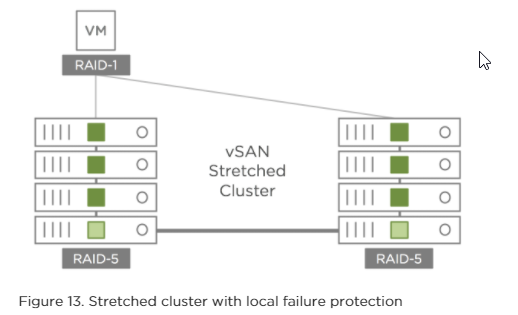VMware vSAN 6.6 which has been announced recently, further enhances stretched clusters configuration. The stretched clusters configuration has been part of vSAN since the 2015 release (v6.1). At that time, the stretched cluster configuration was released with fault domain architecture, where Witness is responsible for quorum and voting mechanism during cluster related failures. The Witness as an ESXi virtual appliance stores only meta-data. The 6.6 release brings what's called a vSAN Affinity for Stretched Clusters.
The previous release of vSAN had the possibility to protect local workloads, at each site, with RAID 1 (FTT=1). The 6.6 release adds a Primary and Secondary level of failure. What's that? It means that you can define a Primary level of failures to tolerate (PFTT) which protects data via cross-site protection (a RAID 1 with two copy of data only, one on each site).
The Secondary level of protection (SFTT), you can define within each site locally, but you can activate not only RAID1 but also RAID5 or RAID6 protection (if you have enough hosts within the site). Note that the secondary level of failures to tolerate is available only when vSAN is configured as stretched cluster.
How does it look like through the UI? Well, so far the product is expected to be released in April, so we'll have to wait a little bit to take our own captures. (for now, I found some images from the latest release at VMware Storage Hub site. (highly recommended to learn new stuff).
So as you can see below, VMware vSAN will be able to have copy of the VMs home at both sites, and at the same time it will be able to handle not only failure of one disk drive within a disk group but also a host failure and at the same time the data won't have to be fetched from the other site, which assures better performance with an additional protection.
Img. courtesy of VMware.

Another image to share which shows the secondary level of failures to tolerate box as well as the fault tolerance method RAID-5/6 (Erasure Coding).
While the stretched cluster scenario is used (obviously) for stretched cluster configs, it is also used for ROBO, as while the ROBO sites were so far good protected with RAID1 only protection, now, the ROBO sites will be able to use the Secondary level of protection (SFTT) and RAID5 can be used to locally protect workloads against failure.
How about Resync operations?
Yes, this is very important to note. In a case of failure. What Happens?
Quote from VMware.
Local failure protection within a stretched cluster further improves the resiliency of the cluster to minimize unplanned downtime. This feature also reduces or eliminates cross-site traffic in cases where components need to be resynchronized or rebuilt. vSAN lowers the total cost of ownership of a stretched cluster solution as there is no need to purchase additional hardware or software to achieve this level of resiliency.
If you have 6 hosts at the local site, you can use RAID6 locally as well as RAID1 within the stretched cluster configuration.
Let's get back to the Site affinity question.
There is an “Affinity” rule where you can specify a single site to locate VM objects in cases where cross-site redundancy is not necessary. One of the examples might be apps such as Microsoft AD, or Oracle Real application clusters (RAC) as those applications have a built-in mechanism for replication, already.
Affinity is easy to configure and manage using storage policy-based management. A storage policy is created and the Affinity rule is added to specify the site where a VM’s objects will be stored.
The current resources:
Note that things are changing quite fast, for vSAN. Imagine that vSAN 5.5 was released only 3 years ago and now we're already with the 6th release…. Pretty impressive job VMware. It also means that hyper convergent infrastructures are getting more and more popular. That traditional “shared storage” silos are good for some use cases, but the mainstream is going Hyper-Converged Infrastructure (HCI).
The resources, yes. There is quite a few. As I mentioned above, the VMware Storage Hub site is getting updated on regular basis. And there are good screenshots, walktrought, new features of vSAN…. the must.
Also, I want to invite you to listen to a very good podcast done (again) by Jase McCarty from VMware, as a part of vCommunity Podcast
 .
.
Wrap UP:
vSAN is maturing into a very good product. When I remember our tiny lab setup with Infiniband and vSAN 5.5 just a few years back, we can only smile. Since then, few years fast forward, the product is much more resilient, much more “user-friendly” and much more suitable for multiple environments.
Yes, while at it's beginning, vSAN was only one site scenario, limited to a “spinning rust”, it was really just the beginning. The vSAN 6.6 introduces 20+ new features. We're far from cover all this, but we love doing this.
We're pretty much sure that you like what we write and that you like the passion we put into it. It would be a real pleasure that you stop using those ugly Ad Block plugins. As you know, this blog is maintained on a daily basis, and there are costs involved with hosting, domain, time. Why not whitelist us? -:)
More posts from ESX Virtualization:
- Dedicated vSphere 6.5 Page
- What is VMware Storage DRS (SDRS)?
- What is VMware vSAN Disk Group?
- What Is Erasure Coding?
- VMware vSAN 6.6 Announced
Stay tuned through RSS, and social media channels (Twitter, FB, YouTube)
